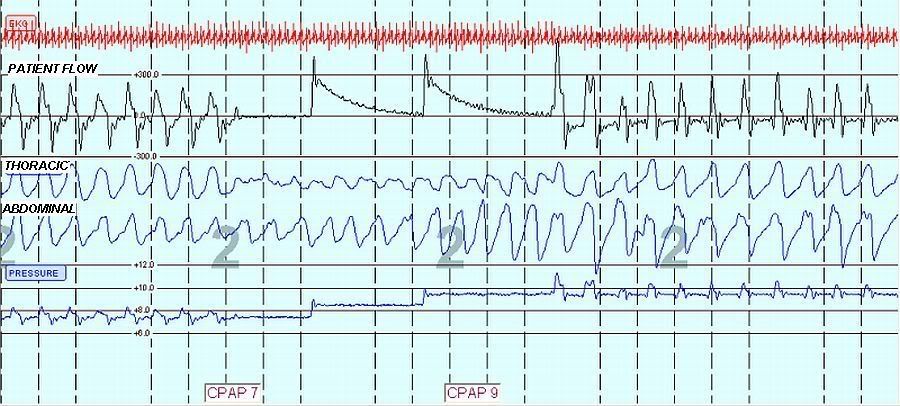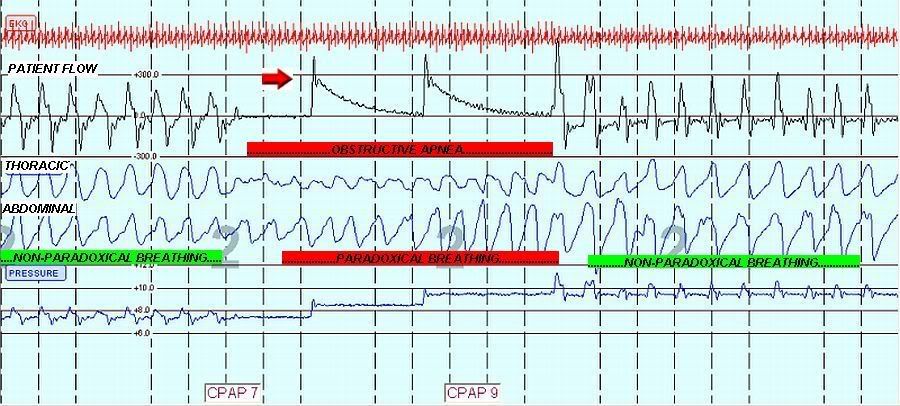BarryKrakowMD wrote:Rested gal, Regarding auto-bilevel, we never set it at 4 and 20, because everyone on this device has undergone a bilevel titration first at our sleep lab. Then we use the standard gap concept, I believe it's 7, and give the patient something close to the range we found on the titration, e.g. 6 to 13 and go from there.
I'm glad to hear that. Sounds like a good way to start their EPAP/IPAP and PS (the "gap") settings on the BiPAP Auto with Bi-flex.
In your example, the machine would start out each night using EPAP 6, IPAP 8. The machine would do its thing from there -- varying those pressures supposedly "as needed."
Personally, I'd let no more than 5 nights go by before doing a download to look at the Daily Details graphs (not the Summary or Trend data) to see if EPAP was actually staying down at 6 most of the time and whether the person was bumping the IPAP ceiling at all. If I saw that EPAP had to go up very often and/or that the machine was hitting the IPAP max at all, I'd raise those pressure settings accordingly.
I especially like to look at the individual nights' "Daily Details" graphs to see what the leak line is doing. I'd want to see that very early (within the first five days) because if significant leaks from mask or mouth are showing up on the data, that needs to be addressed as soon as possible. Massive leaks, even if they don't reach "Large Leak" (LL) levels, can play havoc with how the machine decides what pressure to use.
Seven for "the gap"...the PS setting, or Max Press Sup (Maximum Pressure Support) as it's called in the M series BiPAP Auto ... sounds good. The most that can be set for is 8 . Of course the PS can't be set for more than the difference between min EPAP/max IPAP, which in that example was PS 7 (13 minus 6 = 7 . ) Unless there's a medical reason that an individual person should have a closer gap, I think it
is good to have the PS set for as much as it will allow (given the particular EPAP/IPAP settings) in order to let EPAP and IPAP do their own thing as independently of each other as possible.
All that said, well... I'm not a doctor, of course. Those are just my layperson's opinion about using the BiPAP Auto -- knowing nothing at all about any health issues the individual user might have that would suggest using different settings. A smaller "gap" for PS, for example.
BarryKrakowMD wrote: I'm not sure what other settings the DME uses, but I welcome your suggestions for fine-tuning adjustments and we'll consider those in future patients. Right now, we're trying a few patients on the RESMED auto-bilevel. Last, I'm not clear why you think one-third good results are impressive. As far as I can tell with early data from my center and other centers with whom I collaborate, the success rate on ASV appears to top 80%, and among these successful cases we often here phrases like, "that was the easiest PAP machine I've ever used" or "that was the best night of sleep I've had with a PAP machine."
Well, I'm not sure where an Adaptive Servo Ventilator machine entered the picture when I thought we were originally talking about repeat failures with traditional bilevel being switched to the BiPAP Auto with Bi-flex -- which is not an ASV type of machine. Unless you were using the BiPAP Auto SV instead of the BiPAP Auto with Bi-flex?
Anyway, if regular bilevel is an apple, and BiPAP Auto with Bi-flex is an orange, then I'd say bringing an ASV machine into the comparison mix is like rolling in a grapefruit now.
So, yes...between just the
two types of machines I thought we were discussing --
traditional bilevel and the BiPAP Auto with Bi-flex -- I'd say that to see "dramatic improvement" in almost one-third of the people in a hard core group of
failed bilevel users who are switched to BiPAP Auto
is impressive.
If a completely different type of machine -- one that utilizes Adaptive Servo Ventilation -- helps even more of them... by all means, yes, go for what works for them! Some of the additional "improvers" might very well be CSDB cases.
Back to the BiPAP Auto with Bi-flex:
BarryKrakowMD wrote:I'm not sure what other settings the DME uses, but I welcome your suggestions for fine-tuning adjustments and we'll consider those in future patients.
Well, first and foremost I'd suggest downloading the Smart Card during the first five days -- and choosing "Full Details" to look at when viewing the report. I wouldn't even bother to look at the Summary or Trend data, or even the first three pages of the "Full Details" report. Beginning on page 4 of the Full Details report, look closely at the Daily Details graph for what the EPAP and IPAP are hitting, as well as what the leak rate is doing. Don't look at the overall averages...actually look at the each
individual night's data on those five "Daily Details" graphs.
As for initial settings beyond EPAP/IPAP and Max Press Sup, I think it is extremely important for the DME to try out each "comfort" setting (there will be 8 settings to try, including two "off's") for Bi-flex and for "Rise Comfort." Both cannot be used at the same time. It's either/or, and both can be "off" if using neither suits best. Trying them can be done right in the DME's office or with the DME visiting the home.
Would take probably 15 minutes or less to go through all of them, as that is best done with the user awake and trying each setting for a few breaths. The person doesn't even have to be laying down. The user will know within a few breaths if a feature/setting feels "smooth" or feels abrupt or "not as good" as the previous setting. Personally, Bi-flex at a setting of 3 feels best to me, but setting a rise time instead of setting
any bi-flex level could feel better to the very next person.
My guess is that most DMEs setting up the BiPAP Auto with Bi-flex simply leave the "comfort" settings at their defaults. Or at most might set bi-flex at what the DME was accustomed to setting it -- probably at 2. I doubt that many of them would think it necessary to spend the few extra minutes it would take to get the user's feedback while methodically trying
each bi-flex and
each "rise comfort" setting.
I'd also remind the DME to be sure the PS (Max Press Sup) setting is set for as much as it will allow (8 being as high as it can be set)
after they finish setting the EPAP/IPAP. Because PS will get moved down if, while running through the EPAP/IPAP numbers during the setup, the difference between EPAP/IPAP gets lessened, even temporarily, before the final EPAP/IPAP is chosen. But the PS setting will not go UP automatically when the eventual wider EPAP/IPAP is set. The DME needs to take a last look at the PS and punch that button repeatedly to be sure it's set for the max it will allow. Unless, of course, the prescription calls for a specific PS gap for that person.















